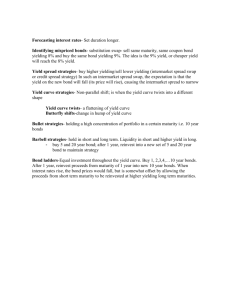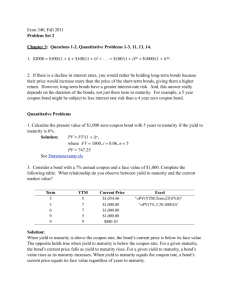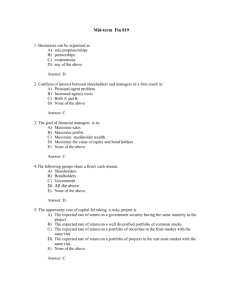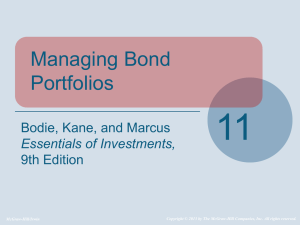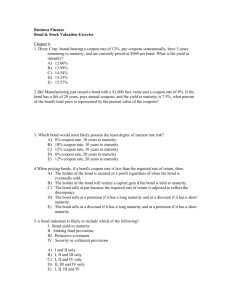Answers
advertisement
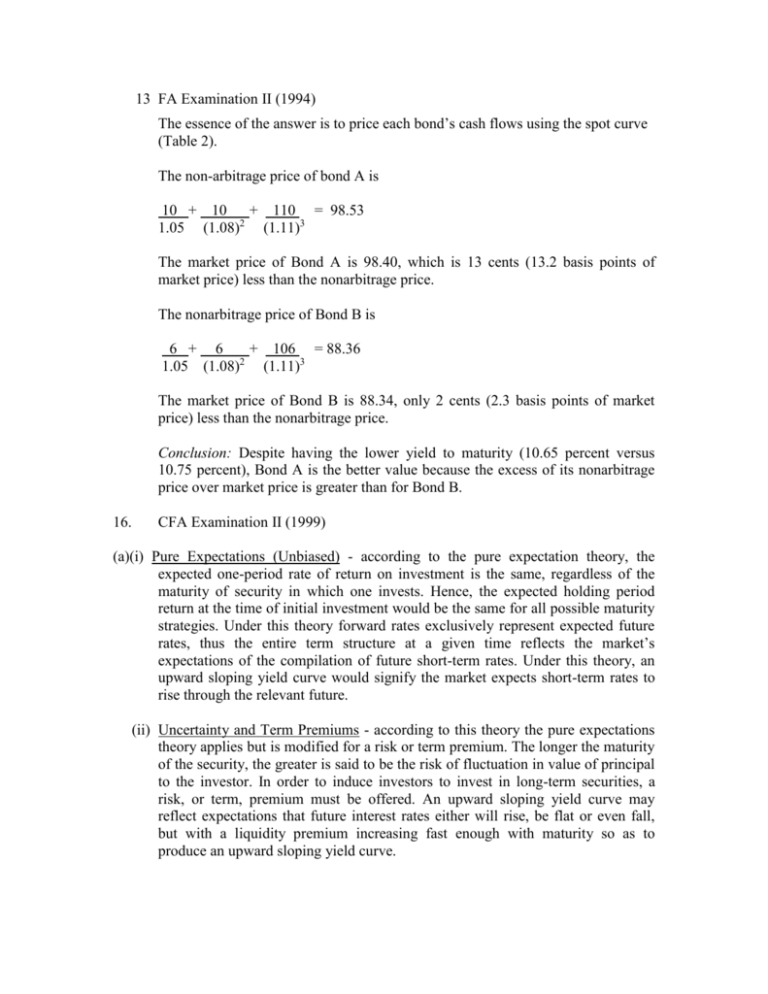
13 FA Examination II (1994) The essence of the answer is to price each bond’s cash flows using the spot curve (Table 2). The non-arbitrage price of bond A is 10 + 10 + 110 = 98.53 2 1.05 (1.08) (1.11)3 The market price of Bond A is 98.40, which is 13 cents (13.2 basis points of market price) less than the nonarbitrage price. The nonarbitrage price of Bond B is 6 + 6 + 106 = 88.36 1.05 (1.08)2 (1.11)3 The market price of Bond B is 88.34, only 2 cents (2.3 basis points of market price) less than the nonarbitrage price. Conclusion: Despite having the lower yield to maturity (10.65 percent versus 10.75 percent), Bond A is the better value because the excess of its nonarbitrage price over market price is greater than for Bond B. 16. CFA Examination II (1999) (a)(i) Pure Expectations (Unbiased) - according to the pure expectation theory, the expected one-period rate of return on investment is the same, regardless of the maturity of security in which one invests. Hence, the expected holding period return at the time of initial investment would be the same for all possible maturity strategies. Under this theory forward rates exclusively represent expected future rates, thus the entire term structure at a given time reflects the market’s expectations of the compilation of future short-term rates. Under this theory, an upward sloping yield curve would signify the market expects short-term rates to rise through the relevant future. (ii) Uncertainty and Term Premiums - according to this theory the pure expectations theory applies but is modified for a risk or term premium. The longer the maturity of the security, the greater is said to be the risk of fluctuation in value of principal to the investor. In order to induce investors to invest in long-term securities, a risk, or term, premium must be offered. An upward sloping yield curve may reflect expectations that future interest rates either will rise, be flat or even fall, but with a liquidity premium increasing fast enough with maturity so as to produce an upward sloping yield curve. (iii) Market Segmentation - this theory suggests that the segmented market behavior of lenders and borrowers basically determine the shape of the yield curve. A market segmentation theory implies that the rate of interest for a particular maturity is determined solely by demand and supply factors for that maturity, with no reference to conditions for other maturities. Borrowers and lenders have rigid maturity preferences and do not deviate from those preferences no matter how attractive the yields are for other maturities. The upward sloping yield curve would signify the greater demand/smaller supply for short-term securities or a greater supply of long-term debt/lesser demand for long-term securities. (b). nft = [(1 + yn+t)n+t /(1 + yn)n]1/t - 1 3f2= [(1 + 0.0651)5' /(1 +0.0619)3]1/2 - 1 3f2 = 6.99% The assumption underlying the calculation of the implied forward rate is risk neutrality among investors. Regardless of the expected holding period, the expected return would be the same for all maturity strategies. That is, it would not matter whether an investor would purchase a one-year investment or purchase a two-year investment and sell it at the end of one year, the return would be the same for any strategy. 23CFA Examination I (1992) 23(a). The notion that stock prices already reflect all available information is referred to as the efficient market hypothesis (EMH). It is common to distinguish among three versions of the EMH: the weak, semi-strong, and strong forms. These versions differ by their treatment of what is meant by “all available information.” The weak-form hypothesis asserts that stock prices already reflect all information that can be derived from studying past market trading data. Therefore, “technical analysis” and trend analysis, etc., are fruitless pursuits. Past stock prices are publicly available and virtually costless to obtain. If such data ever conveyed reliable signals about future stock performance, all investors would have learned to exploit such signals. The semi-strong form hypothesis states that all publicly available information about the prospects of a firm must be reflected already in the stock’s price. Such information includes, in addition to past prices, all fundamental data on the firm, its product, its management, its finances, its earnings, etc., that can be found in public information sources. The strong-form hypothesis states that stock prices reflect all information relevant to the firm, even including information available to company “insiders.” This version is an extreme one. Obviously, some “insiders” do have access to pertinent information long enough for hem to profit from trading on that information before the public obtains it. Indeed, such trading - not only the “insiders” themselves, but also relatives and/or associates - is illegal under rules of SEC. For weak-form or the semi-strong forms of the hypothesis to be valid does not require the strong-form version to hold. If the strong-form version was valid, however, both the semi-strong and the weak-form versions of efficiency would also be valid. 23(b). Even in an efficient market, a portfolio manager would have the important role of constructing and implementing an integrated set of steps to create and maintain appropriate combinations of investment assets. Listed below are the necessary steps in the portfolio management process. 1. Counseling the client to help the client to determine appropriate objectives and identify and evaluate constraints. The portfolio manager together with the client should specify and quantify risk tolerance, required rate of return, time horizon, taxes considerations, the form of income needs, liquidity, legal and regulatory constraints, and any unique circumstances that will impact or modify normal management procedures/goals. 2. Monitoring and evaluating capital market expectations. Relevant considerations, such as economic, social, and political conditions/expectations are factored into the decision making process in terms of the expected risk/reward relationship for the various asset categories. Different expectations may lead the portfolio manager to adjust a client’s systematic risk level even if markets are efficient. 3. The above steps are decisions derived from/implemented through portfolio policy and strategy setting. Investment policies are set and implemented through the choice of optimal combinations of financial and real assets in the marketplace - i.e., asset allocation. Under the assumption of a perfectly efficient market, stocks would be priced fairly, eliminating any added value by specific security selection. It might be argued that an investment policy which stresses diversification is even more important in an efficient market, context because the elimination of specific risk becomes extremely important. 4. Market conditions, relative asset category percentages, and the investor’s circumstances are monitored. 5. Portfolio adjustments are made as a result of significant changes in any or all relevant variables. 2. ARit = Rit - (beta) (Rmt) ARBt = 11.5 - .95(4.0) = 7.7 ARFt = 10.0 - 1.25(8.5) = -.625 ARTt = 14.0 - 1.45(9.6) = .08 ARCt = 12.0 - .75(15.3) = .525 AREt = 15.9 - (-.3)(12.4) = 19.62 6. CURRENT BOND Dollar Investment 839.54 Coupon 90.00 i on One Coupon 2.59 Principal Value at Year End 841.95 Total Accrued 934.54 Realized Compound Yield 11.0125 CANDIDATE BOND 961.16 110.00 3.16 961.71 1,074.87 11.4999 Value of swap: 48.6 basis points in one year P0 = 45 x (16.04612) + 1,000 x (.11746) = 839.54 P0 = 55 x (15.53300) + 1,000 x (.10685) = 961.16 P0 = 45 x (15.80474) + 1,000 x (.13074) = 841.95 P0 = 55 x (15.31315) + 1,000 x (.11949) = 961.71 where: 16.04612 is the PVA factor and .11746 is the PV factor, both for 40 periods at 5.5 percent per period. 15.53300 is the PVA factor and .10685 is the PV factor, both for 40 periods at 5.75 percent per period. 15.80474 is the PVA factor and .13074 is the PV factor, both for 38 periods at 5.5 percent per period. 15.31315 is the PVA factor and .11949 is the PV factor, both for 38 periods at 5.75 percent per period.



